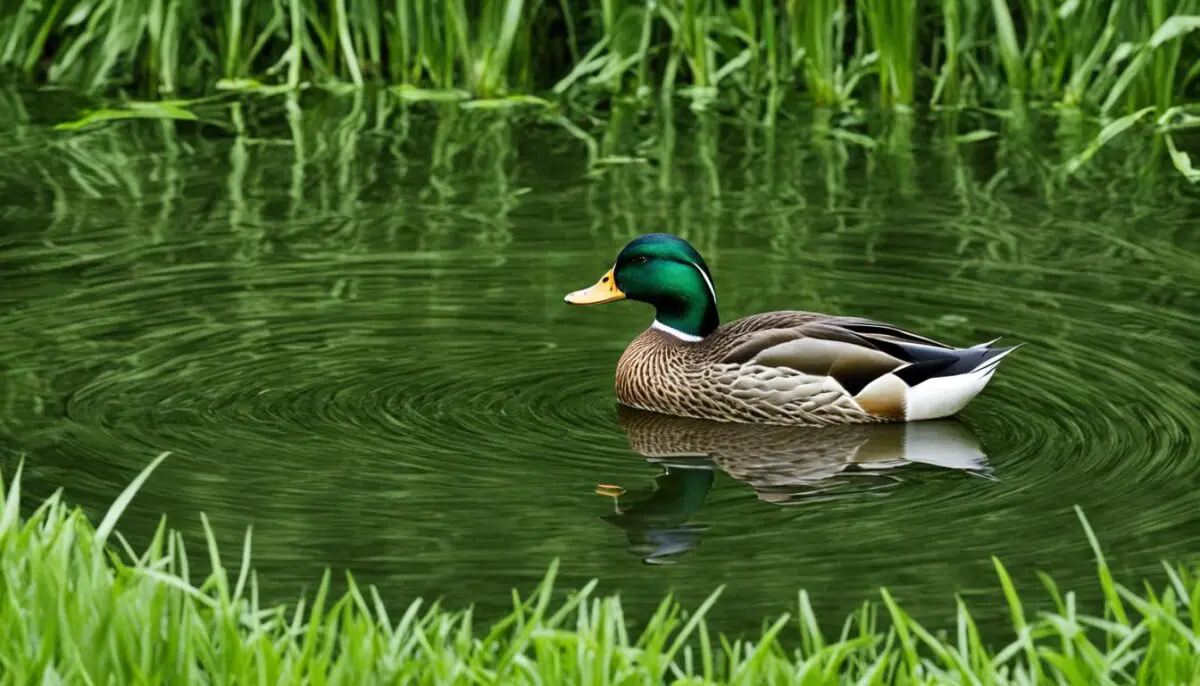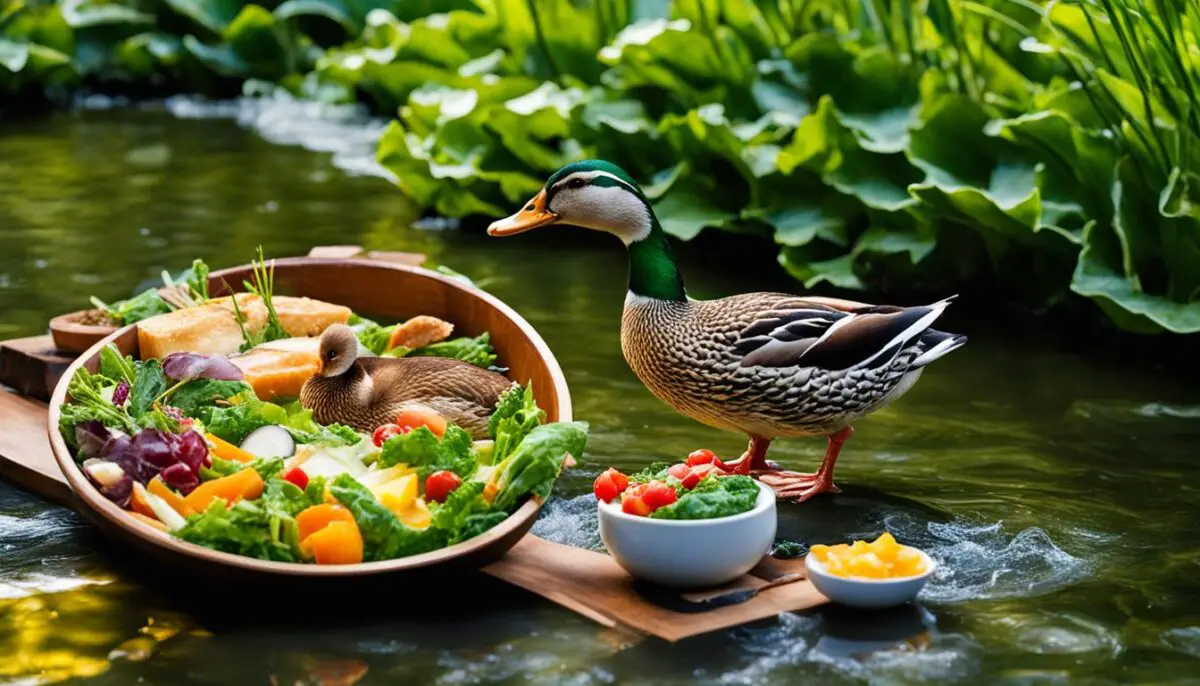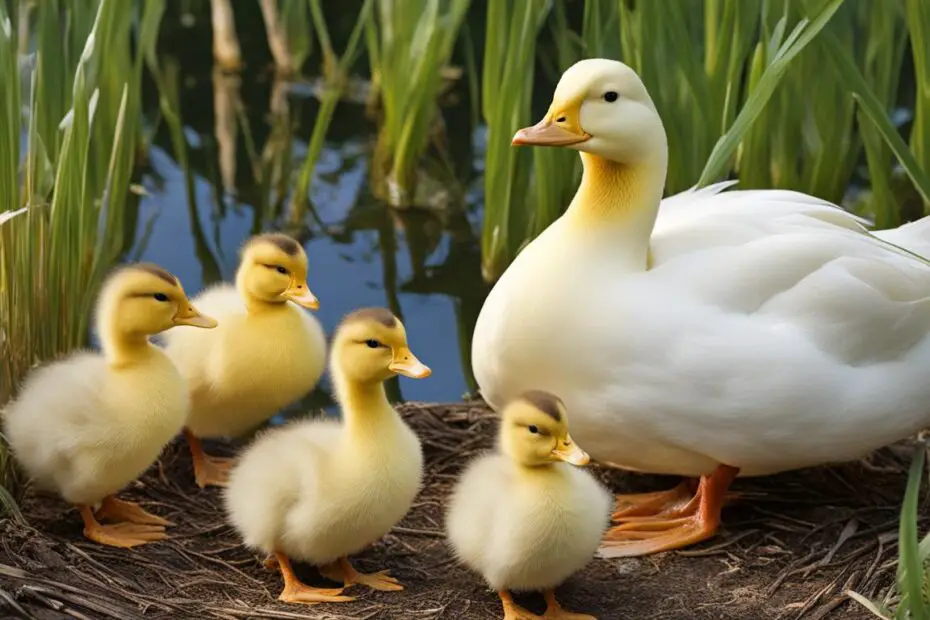The American Pekin is a popular domesticated duck breed known for its creamy white plumage. Originating in China and introduced to the United States in 1873, American Pekin ducks have become the most common breed of domestic ducks in the country.
Many people are curious about the lifespan of American Pekin ducks. On average, these ducks can live for around 10-15 years, although some may live longer with proper care and conditions. The lifespan of Pekin ducks can be influenced by various factors, including genetics, diet, environment, and general care.
Key Takeaways:
- American Pekin ducks have an average lifespan of 10-15 years.
- Genetics, diet, environment, and general care can affect the lifespan of American Pekin ducks.
- Proper care and conditions can contribute to the longevity of these ducks.
- American Pekin ducks are the most common breed of domesticated ducks in the United States.
- Originating in China, American Pekin ducks were introduced to the United States in 1873.
Domesticated Ducks and Their Unique Challenges
Domesticated ducks, like the American Pekin, face a range of challenges in commercial farming. Over the years, selective breeding has been employed to develop larger and faster-growing duck bodies, but this has also resulted in various health issues. Ducks in commercial farms often endure crowded and unsanitary living conditions, which can lead to the spread of diseases and foot problems. Additionally, reproductive diseases such as peritonitis and egg yolk impactions are common among ducks bred specifically for egg production. Complicating matters further, domesticated ducks currently lack legal protection under the United States government’s Animal Welfare Act.
“Selective breeding has led to larger and faster-growing ducks, but it has also brought about a host of health challenges.”

The Khaki Campbell duck is a small and active breed that is highly regarded for its egg-laying ability. Khaki Campbell ducks are exceptional layers, producing an average of 300 to 340 eggs per year. They have a khaki-colored plumage with dark markings on the head and back.
Crested
The Crested duck stands out with its distinctive crest of feathers on top of its head. This breed comes in various colors, including black, blue, and white. Crested ducks are primarily kept as ornamental birds due to their unique appearance.
Swedish Blue
The Swedish Blue duck is a medium-sized breed known for its striking blue plumage. It is a hardy and active breed that adapts well to different climates. Swedish Blue ducks are primarily raised for meat but can also lay a decent number of eggs.
Duclair
The Duclair duck is a French breed that is known for its beautiful appearance. It has a distinctive blue-gray plumage with white flecks. Duclair ducks are primarily kept for exhibition and ornamental purposes.
Call
The Call duck is a miniature breed with a friendly and sociable nature. It comes in various colors, including white, gray, and mallard. Call ducks are mainly kept as pets due to their small size and charming personality.
Magpie
The Magpie duck is a breed known for its striking black and white plumage. It is a medium-sized breed that is known for its calm and friendly temperament. Magpie ducks are versatile and can be raised for meat, eggs, or as pets.
Each breed of duck has its own unique set of characteristics, making them suitable for different purposes and preferences. Whether you’re looking for a meat producer, an excellent egg layer, or simply a beautiful ornamental bird, there’s a duck breed out there for you.
Growth Traits and Slaughter Value of Different Duck Lines
Research studies have explored the growth traits and slaughter value of various duck lines, shedding light on their genetic characteristics and potential uses. One such study compared the growth traits of Pekin ducks from different origins, revealing interesting differences in body weight, breast muscle content, and abdominal fat percentage.
“Pekin ducks of Danish origin (line P8) exhibited higher body weight and breast muscle content compared to those of French origin (line P9) and Polish origin (line P33). However, the different duck lines also showed variability in terms of abdominal fat percentage.”
These findings suggest that selective breeding and genetic factors play a significant role in determining the growth traits of different duck lines. The higher body weight and breast muscle content observed in ducks of Danish origin could be of interest to farmers and breeders looking to produce meat with desirable qualities.
Understanding the growth traits of different duck lines is crucial for optimizing production and selecting the most suitable duck breeds for specific purposes. Farmers and breeders can utilize this knowledge to enhance meat yield, maximize slaughter value, and meet market demands. However, it is essential to consider other factors such as feed quality, management practices, and environmental conditions that can also influence the growth and development of ducks.
Comparative Growth Traits of Different Duck Lines
| Duck Line | Body Weight | Breast Muscle Content | Abdominal Fat Percentage |
|---|---|---|---|
| Danish Origin (Line P8) | Higher | Higher | Variable |
| French Origin (Line P9) | Lower | Lower | Variable |
| Polish Origin (Line P33) | Lower | Lower | Variable |
Note: The values in the table are based on research studies and may vary depending on specific breeding practices, environmental conditions, and other factors.

Nutritional Requirements of Ducks at Different Stages of Growth
| Stage of Growth | Nutritional Requirements |
|---|---|
| Ducklings (0-2 weeks) | High protein feed (18-20% protein), starter feed with essential amino acids, vitamins, and minerals |
| Growing Ducks (3-9 weeks) | Lower protein feed (15-18% protein), growth feed with balanced nutrition for optimal growth |
| Laying Ducks (10+ weeks) | Laying feed with higher calcium content (16-18% protein), supplemented with vitamins and minerals for egg production |
Table: Nutritional Requirements of Ducks at Different Stages of Growth
Management and Care of Ducks
Proper management and care are essential for the health and well-being of ducks. By providing the right environment, health care, and reproductive management, we can ensure that ducks thrive and live their best lives.
Shelter and Protection
Ducks require suitable shelter to protect them from the elements and predators. A well-constructed duck house or coop can provide them with a safe and comfortable place to rest, lay eggs, and seek protection from predators. The shelter should have adequate space for the ducks to move around and provide nesting boxes or areas for them to lay their eggs.
Duck Health Care
Regular health care is vital for maintaining the overall well-being of ducks. This includes vaccinations and deworming to prevent and treat diseases. Consulting with a veterinarian who specializes in avian health can help ensure that ducks receive the necessary vaccinations and preventive care. Regular health check-ups can also help identify any health issues early on and provide prompt treatment.
“Regular health care, including vaccinations and deworming, plays a crucial role in keeping ducks healthy and disease-free.” – Dr. Avian Health
Reproduction Management
For duck breeders, proper reproduction management is important to ensure successful breeding and healthy offspring. This includes providing suitable nesting areas for egg-laying ducks, monitoring egg production, and ensuring that eggs are incubated at the correct temperature and humidity levels. Breeding ducks should also be selected based on their genetic traits and overall health to maintain the quality of the breed.
Access to Clean Water
Providing ducks with access to clean water is essential for their well-being. Ducks use water for drinking, grooming, and swimming, which helps keep their feathers clean and in good condition. Additionally, ducks naturally forage for food in water, so having access to clean water aids their natural feeding behaviors.
Duck Management Checklist
| Aspect | Management Practices |
|---|---|
| Shelter | Provide a well-constructed duck house or coop for protection from the elements and predators. |
| Health Care | Administer regular vaccinations and deworming, and consult with a veterinarian for routine check-ups and prompt treatment. |
| Reproduction | Ensure suitable nesting areas, monitor egg production, and implement proper incubation techniques for successful breeding. |
| Water | Provide clean water for drinking, swimming, grooming, and natural foraging behaviors. |
In summary, effective management and care practices contribute to the overall health and well-being of ducks. Providing suitable shelter, regular health care, proper reproduction management, and access to clean water are essential for their thriving. By prioritizing the management and care of ducks, we can ensure their optimal health, protection, and longevity.
Conclusion
In conclusion, the American Pekin is a popular domesticated duck breed with an average lifespan of about 10-15 years. These ducks, known for their creamy white plumage, have been in the United States since their introduction in 1873.
Several factors can affect the lifespan of American Pekin ducks, including genetics, diet, environment, and general care. Responsible breeding and proper nutrition play a significant role in ensuring the longevity and overall well-being of these waterfowl.
While domesticated ducks face unique challenges in commercial farming, understanding their characteristics and providing appropriate management and care can mitigate these issues. It’s important to note that releasing domesticated ducks into the wild can pose significant challenges, as they are ill-suited for survival without human support.
By recognizing the specific needs of different duck breeds, such as the American Pekin, and implementing suitable feeding programs, shelter, and health care measures, we can contribute to the longevity of these fascinating birds. With proper attention to these factors, we can help ensure that American Pekin ducks live healthy and fulfilling lives.
FAQ
What is the average lifespan of American Pekin ducks?
The average lifespan of American Pekin ducks is around 10-15 years, although some can live longer.
What factors can influence the lifespan of American Pekin ducks?
Several factors can influence the lifespan of American Pekin ducks, including genetics, diet, environment, and general care.
What are the challenges faced by domesticated ducks in commercial farming?
Ducks in commercial farms often face challenges such as crowded and unsanitary conditions, which can lead to diseases and foot problems. Reproductive diseases are also common in ducks bred for their egg-laying ability.
How do domesticated ducks fare when released into the wild?
Domesticated ducks face difficulties in the wild, including struggles to find appropriate food sources and potential malnutrition. Hybridization between domesticated and wild ducks can result in genetic and behavioral issues for both populations.
What are some popular duck breeds apart from the American Pekin?
Other popular duck breeds include Buff Orpington, Indian Runner, Khaki Campbell, Crested, Swedish Blue, Duclair, Call, and Magpie ducks. These breeds vary in size, color, egg production, temperament, and other traits.
Are there differences in growth traits and slaughter value among different duck lines?
Yes, studies have found variations in body weight, breast muscle content, and abdominal fat percentage among different duck lines.
What are the nutritional requirements for ducks and their feeding programs?
Ducks have specific nutritional requirements that should be met for optimal health and growth. Commercial duck feed is available and should be formulated based on their age and growth stage.
How should ducks be managed and cared for?
Ducks require suitable shelter, regular health care, access to clean water, and proper reproduction management for breeders. Good management and care practices contribute to overall duck health and well-being.
What are the key factors affecting the average lifespan of American Pekin ducks?
The average lifespan of American Pekin ducks can be influenced by genetics, diet, environment, and general care.

